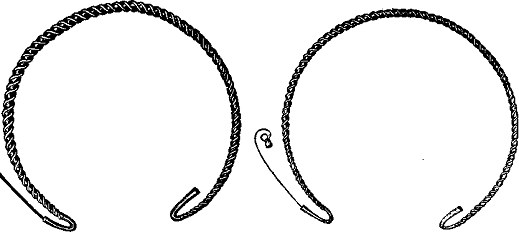Golden Torques in Ireland
[From the Dublin Penny Journal, Vol. 1, No. 19, November 3, 1832]
In our little history of the progress of the Fine Arts in Ireland in a former number, page 84, we made mention of the numerous golden ornaments of a very remote age which are being constantly discovered, and among others, alluded to the golden Torques or collars. As illustrations of these we now present our readers with two fine examples, lately to be seen in Dublin.
The form of these ornaments, which are of fine gold and excellent workmanship, will be best understood by the engravings. The first is 5 feet 7 inches in length and weighs 27oz. 9dr. The second is 5 feet 6 inches in length, but weighs only 12oz. 6dr. Ornaments of the same description, but of far less intrinsic value, are often found in Ireland; a beautiful specimen in the museum of Major Sirr, only weighs between 3 and 4 ounces. They are frequently found with Armillae or bracelets of the same pattern.

These ornaments are of that description known among antiquarians under the Roman appellation of Torques or Torquis, a word generally derived from the Celtic Torc, a twisted collar. They appear to have been common to all the Celtic nations as we find from ancient writers. Livy tells us that, Publius Cornelius in his triumph over the Bori, a Gaulic nation, collected among other spoils no less than 1470 Torques; and we find in Propertius, that Britomartus a commander of the Gauls wore such an ornament. Dio Cassius notices a Torq of this description as ornamenting the person of the British queen Boadicea; and even within a few centuries of the present time a Welsh Prince was called Llewellyn aur dorchag, or Llewellyn of the golden Torq. The Torques found in France and Wales, are exactly similar to the Irish; a fine one found near Harlech, in the year 1692, is preserved in the Mostyn family in Flintshire.
It has been supposed by some Antiquarians that the use of these ornaments was derived from the Romans. But the great number discovered in Ireland—the writer has himself seen not less than eight—is opposed to such a conjecture, and we may with much greater probability refer them to a Celtic origin. It does not appear that they were generally worn by the Romans, and the very appellation, Torquatus, bestowed on Titus Manlius, from the golden Torq taken by him from a Gaul whom he slew in the year 398, and which was worn by his family as a badge of distinction for so many ages afterwards, seems to support this conclusion. Besides, they are not found in the ruins of Roman Cities.
These ornaments were found about twenty years since, in the County of Meath, in the neighbourhood, as it is said, of the celebrated hill of Tara, the seat of the palace of the supreme monarch of Ireland in very ancient times. They were originally purchased by the late Alderman West of Skinners' Row, after the breaking up of whose establishment they passed into the hands of the present alderman of the same name, and have ultimately found a purchaser in his Royal Highness the Duke of Sussex.
P.
